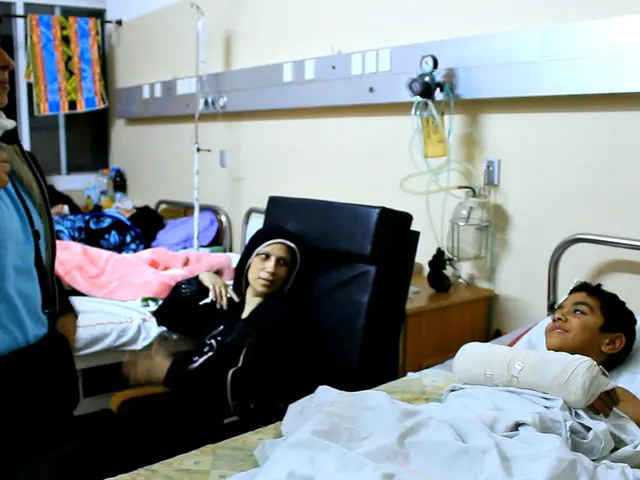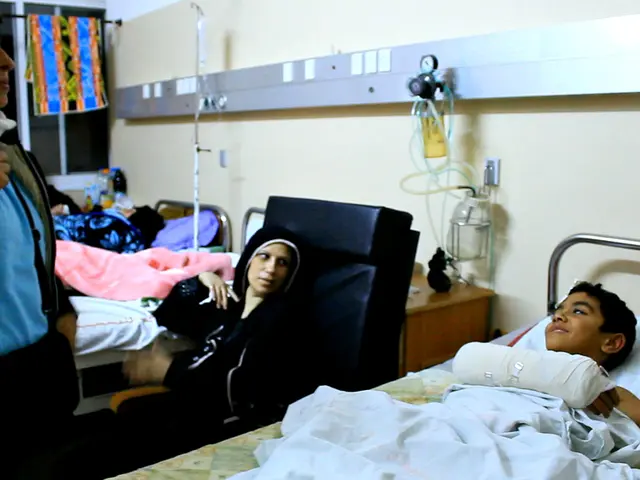Necrotizing Fasciitis: A Serious Type of Infection That Can Destroy Soft Tissue and Cause Severe Damage if Untreated
Necrotizing fasciitis is a severe and rapidly progressing infection that affects the soft tissues of the body, particularly the fascia. This condition can lead to serious complications, including sepsis, amputation, and even death if not treated promptly.
The infection can be triggered by various factors, such as a weakened immune system, chronic health conditions, recent surgery or trauma, and intravenous drug use. It's essential to understand these risk factors to take preventative measures and seek early treatment.
Early symptoms of necrotizing fasciitis may include redness and swelling, severe pain disproportionate to the visible symptoms, and fever. As the infection progresses, symptoms can worsen rapidly, leading to blisters or bullae, skin changes, and a foul odor.
If left untreated, the infection can cause tissue death, necessitating amputation of the affected limb or body part. In severe cases, patients may require admission to an intensive care unit (ICU) for close monitoring and advanced care.
In addition to surgical intervention, antibiotic therapy plays a crucial role in managing necrotizing fasciitis. Broad-spectrum intravenous antibiotics, such as Penicillin, Vancomycin, and Clindamycin, are commonly used. The choice of antibiotic may be adjusted based on culture results and the specific bacteria identified. It's essential to complete the full course of antibiotics as prescribed.
Debridement, the surgical removal of all necrotic (dead) tissue, is also an essential part of the treatment process. In some cases, a fasciotomy may be performed to relieve pressure in the affected area.
Survivors of necrotizing fasciitis may face long-term health issues, including chronic pain, mobility limitations, and psychological effects such as post-traumatic stress disorder (PTSD). Many survivors require reconstructive surgeries (e.g., skin grafts) and ongoing physical therapy to regain strength and function. Psychological support is often necessary to help address emotional challenges related to the disease and its aftermath.
Common long-term effects and complications experienced by survivors include physical disabilities such as chronic pain, impaired mobility, and possible amputations, as well as significant psychological impacts like trauma, anxiety, and body image issues.
Mortality and amputation rates are high in necrotizing fasciitis, with about 29% of patients succumbing to the infection and approximately 28.9% undergoing amputation during initial treatment, amplifying the long-term morbidity for survivors.
To reduce the likelihood of developing necrotizing fasciitis, maintaining good hygiene, promptly treating wounds, being cautious with chronic conditions, avoiding risky environments, and educating yourself and others about the signs and symptoms of the condition can help. Timely diagnosis and treatment are crucial for improving outcomes and reducing the risk of complications.
Staphylococcus aureus, including methicillin-resistant strains (MRSA), and Group A Streptococcus are common bacteria causing necrotizing fasciitis. As the infection spreads, it can affect vital organs, leading to organ failure.
In summary, necrotizing fasciitis is a serious and potentially life-threatening condition that requires prompt medical attention. Understanding the causes, risk factors, and treatment options is vital for prevention, early intervention, and improving outcomes for those affected.
In the context of health and wellness, understanding that medical-conditions such as necrotizing fasciitis can be triggered by factors like weakened immune systems, chronic health conditions, or recent trauma, is essential for taking preventative measures and seeking early treatment. Additionally, skin-conditions associated with necrotizing fasciitis, like blisters, skin changes, and a foul odor, are early signs that should prompt immediate medical attention to prevent serious complications such as tissue death and amputation.






